Entries Tagged as 'Radio'

“American vs. Canadian Radio” — drawn by bing.com/images/create
A couple of years ago I was asked on Quora, “How do American radio stations compare to Canadian stations?” This was my answer.
Mostly the differences are regulatory. But some are also geographic. Examples:
- The Canadian government has a national network, the CBC, much as does the U.K. with the BBC. And, like the BBC, it’s very reputable. Both are “royal” entities, for which there is no U.S. equivalent. (And no, NPR doesn’t qualify, since it’s independent of the federal government and almost entirely—last report, 98+%—paid for by member stations, sponsorships and underwriting.)
- Programming is more highly regulated, especially around music, in Canada. For example, the Canadian Radio-Televsion and Communmicatons Commission (CRTC) has Canadian content requirements for music on Canadian radio, which requires that commercial, community, campus and native radio stations “must ensure that at least 35% of the Popular Music they broadcast each week is Canadian content.” The percentage for CBC stations is 50%.
- The CRTC is committed to sunsetting AM broadcasting, while the FCC is not. While there are still some CBC stations still on the AM band, many signals have either gone dark or have been sold off. Here is a list of the remaining CBC AM signals.
Despite Canada’s slow rollback of AM broadcasting, its prairie features an AM station with the largest daytime* coverage in the world: CBK/540 in Watrous, Saskatchewan. While there are lots of 50,000-watt stations in the world (and that’s the max allowed in the U.S. and Canada)—and a handful cranking out up to two million watts—CBK’s 50,000-watt transmitter sits on some of the most conductive dirt in the world, giving the station coverage that reaches from the Rockies in Alberta to the west, the shores of Hudson Bay to the east; and north across the borders of the Northwest Territories and Nunavut, and well into Montana, North Dakota, and Minnesota to the south:
One of those two million-watt giants is Transmitter Solt, for Kossuth Rádió, Hungary’s national radio station. While its signal is immense electronically, its daytime* coverage, while very large, is limited by relatively nonconductive ground. Still, in a way, Transmitter Solt is also Canadian, since the transmitter itself is made by Nautel, of Nova Scotia, which in recent years has become what some regard as the preeminent maker of broadcast transmitters.
______________________
*Note that coverage by day and night is vastly different for AM (aka MW) radio. That’s because in daytime the lowest (D) layer of the ionosphere absorbs signals in that band, and at night the same signals bounce off the next layer up (E) for distances typically of several hundred miles. Or, in cases like Transmitter Solt, thousands of miles. As a somewhat separate matter, shortwave signals bounce off the higher F1 and F2 layers. Check that last link for particulars.
Tags: Broadcasting · Geography · Radio
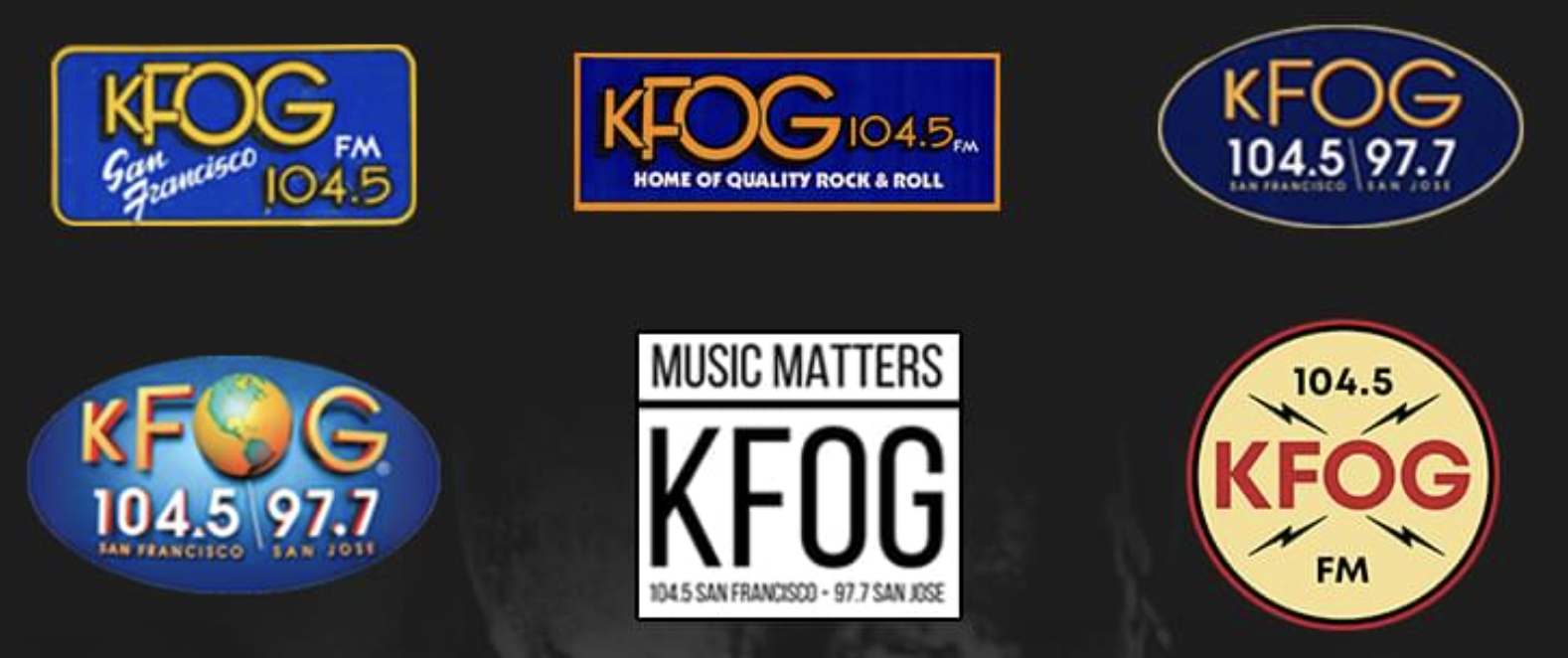
When I moved to Palo Alto from North Carolina in 1985, the preëminent rock station for the Bay Area was KFOG, on 104.5 FM. The morning jock was M. Dung (the on-air handle of Michael Slavko), who did more than anyone else to make me feel comfortable and welcome in a completely new environment. Like the rest of the station, M (what he usually called himself) was “always on, but a little off.”
My fave rock station in North Carolina had been WRDU/106.1, to which many friends who had worked at WQDR/94.7 had just migrated after that much-loved station flipped to country music. (A genre I also like, but we’re talking about friends here.)
From 1982 to 2017, KFOG was a great friend to fans of rock and related genres. You can see how much it was loved just by searching for it. The top results are tribute sites KFOG.com and KFOGisForever. Below those are a list of heartfelt lamentations.
I’ll carry this forward with my answer to a Quora question: Will 104.5 FM in San Francisco ever flip back to any music format?
In American radio, very few station formats are permanent. Two of the most durable are all-news and all-sports. For decades, the biggest all-news and all-sports stations in major markets were only on AM signals. Nearly all of those stations in recent years have added FM signals, displacing whatever was on the FM channel they moved to. All-news WINS/1010 in New York, WBBM/780 in Chicago, and KNX/1070 in Los Angeles moved to 92.3, 105.9, and 97.1 respectively, replacing the music stations on those channels. All-sports WEEI/850 in Boston and WFAN/660 in New York did the same when they moved to 93.7 and 101.9 in those cities. And KNBR/680 did the same in San Francisco when it added the signal at 104.5, long the home of KFOG.
Never mind that KNBR’s day signal covers a third of California and its night signal covers the whole Western U.S., while KFOG’s old signal barely covers the Bay Area. AM is a dead band walking. FM is where the listening is, and the signal at 104.5 is at least competitive. By now there are very few incumbent ratings leaders on AM that have not added an FM signal. KFI/640 in Los Angeles, WLW/700 in Cincinnati, KOA/850 in Denver, and WSCR/670 in Chicago are four that come to mind. There are a handful of others. Even with those, I’m sure it’s a matter of time before their owners find an FM signal to add.
In the longer term, FM is doomed as well. The Internet is slowly eating away at every incumbent communications medium: print, radio, TV, all of it. Your best radio is now the phone in your pocket or purse. All stations of any importance are there as well as on old-fashioned broadcast bands. If you want to hear KFOG again, there are a number of websites streaming the old programs. Nearly every piece of recorded music ever played on KFOG is also on music services from Apple, Amazon, Spotify, and other sources.
Here is another reason why KFOG is unlikely to return to the airwaves: rock music is still with us, but its era is over. We could argue that, but look up Rock Era and see what comes up. KFOG played a lot of genres other than pure rock (one of the things that made the station distinctive), but it was still a rock station.
Music genres today are largely created and maintained online, rather than on the air.
But hey, maybe the old KFOG will return someday.
But, if it does, it will need to pry the callsign from its current holder: KFOG/1250 in Little Rock, Arkansas. Might be a long shot, but money talks. If there is an economic case, it’s one worth making. And, for what it’s worth, the station mostly identifies as “Power 92” (named for its FM signal), and I read in June that the AM side was off the air.
In respect to infrastructure (the theme of this blog), my point is this: As we move into the Digital Age, the Internet and digital tech will finish absorbing and obsolescing every old analog communication system.
Radio’s age lasted roughly from the early twenties of the twentieth century to the early twenties of the twenty-first. Some of what it was will live on through streams and podcasts online. But it’s a matter of time before radios will only play hiss.
Tags: Broadcasting · Future · History · Industry · Over-the-Air (OTA) · Radio
November 9th, 2023 · 2 Comments
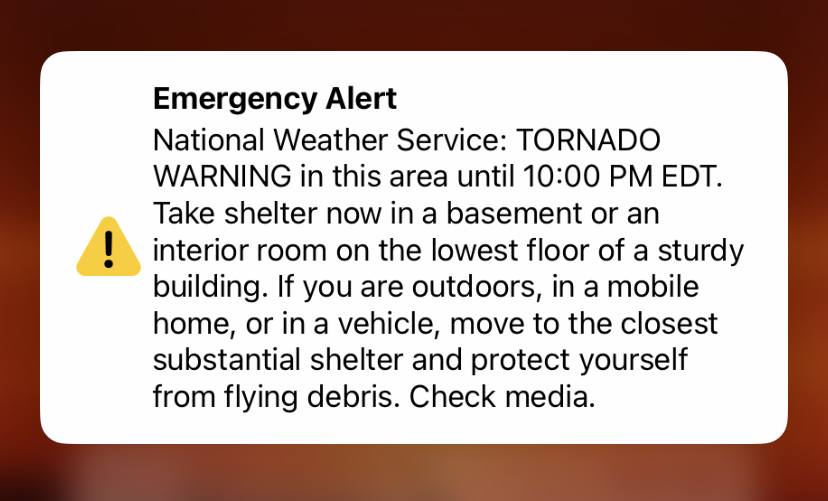
A few months ago, here in Bloomington, Indiana, everyone’s cell phone blasted an emergency warning sound, along with the alert above: a tornado waring. At the same time, civil emergency sirens wailed all over town.
A TORNADO WARNING means a tornado has been spotted or close enough. (A WATCH means there is a risk of a tornado.) Note the last two words: Check media.
That we did, here in the basement where I’m sitting right now. (It’s my office.) First I went to our only local AM station, WGCL/1370 (also 89.7 on FM). On the air was an interview with a guy talking about his tattoos. Then I checked all the local and regional radio stations listed here (on the LocalWiki where I dutifully put them):
Nothing. On any of them. Not even on WFIU, which is the substantial public station at Indiana University.
While I fiddled around with a portable radio, my wife wisely asked, “Have you checked Twitter?” I hadn’t, so I opened a browser on my computer, searched for #Bloomington and #Tornado, and got all the information we needed: everyone was hunkering down, and nobody had seen a tornado. So, we all lucked out.
But the experience was relevant to the regulatory alarms that were being raised, about car makers’ plans to drop AM radio from their cars’ dashboard infotainment systems. For example, Massachusetts Senator Ed Markey’s bill S. 1669: AM Radio for Every Vehicle Act of 2023 seeks required inclusion of AM radios in cars, so IPAWS, the Integrated Public Alert And Warning System “described in section 526 of the Homeland Security Act of 2002 (6 U.S.C. 321o)” (says the bill) would blast through AM radios, and hopefully save some listeners’ asses.
In a press release, the good Senator said this: “Unlike FM radio, AM radio operates at lower frequencies and longer wavelengths, enabling it to pass through solid objects and travel further than other radio waves.”
Not exactly. AM and FM work differently, but both have limited range, and every station has its own coverage pattern. And none of those equal cellular Internet and satellite radio in overall coverage, though both of those have limitations as well.
[As an aside, not long after I wrote this post, I visited two stations in one studio in Palm Springs, California, and published a photo album of the visit here. Best I can tell, both stations live off rent to cell companies for the tower behind their studios. And they don’t even own the tower anymore. A company that specializes in cell towers and rental owns it, and pays the station owner for the right to occupy the land. From what I saw, neither station was ready to deal with an emergency. Sure, maybe somebody could be called in, but on-site staffing was the exception, not the rule. Oh, and there was a third station once transmitting from the site, but that one was kindly donated to a local college whose staff and students weren’t interested in it, and turned in the license.]
If we were to zero-base radio today, we probably wouldn’t have stations at all. We’d have streams and podcasts, over the Internet, coming from anybody who wants to put out whatever they please. It would all be delivered by fiber, copper wiring, and cellular wireless, perhaps with satellite broadcasting thrown in.
Of course, we have that already.
By the way, Markey’s ploy worked, to some degree. For example, Ford reversed its plans to drop AM radio from its new cars. But AM towers everywhere are being logged off land sold to make room for housing developments and shipping centers. Examples: WMAL in Washington, WFNI in Indianapolis, and WFME in New York—to name a few among many.
Almost all the rest persist on shoestring budgets. You hear programming (now re-dubbed “content”) on their airwaves, but in most stations you will find no human beings sitting in a studio and working a control board with a microphone in their face. Those people got laid off long ago. Nearly all content is piped in from elsewhere. Voices included.
AM also sounds like shit. It doesn’t have to, but it does. For that problem you can mostly blame the radio makers, especially for cars. Switch from FM to AM, and it sounds like somebody just put a pillow over the speakers.
The simple fact is that AM radio is moving toward obsolescence while its popularity drops toward zero. (Ratings on the whole are bad and getting worse.)
Of course, emergency notifications are important. The question of how best to blast out those notifications and then get good news coverage during and after an emergency can be answered in lots of ways. But keeping AM stations running may not be the best of those options.
Tags: Broadcasting · Emergency · Radio
September 24th, 2022 · No Comments

MEGO in journalism stands for My Eyes (or Ears) Glaze Over. According to William Safire , a MEGO os “a subject of great importance which resists reader interest.”
Infrastructure is a one-word MEGO.
So I haven’t written much about infrastructure, including here: on a blog created by Christain Sandvig when we were both fellows at the Berkman Klein Center. It was meant as a place where learned folk who care about infrastructure could hold forth. A variety of those was recruited to participate, and approximately none did, including me. I’ve kept it alive in recent years by posting here occasionally, mostly with stuff that I think fits better here than anywhere else I tend to write.
In the meantime, I have kept an active site on the topic going: a Flickr account with the name Infrastructure. My chief interest there is in showing the plasticity of infrastructure over time: how it changes or gets replaced. I am especially interested in forms of infrastructure that are out of sight, mind, or booth, but on which we depend completely. These include water, gas, electricity, waste treatment… all the usual.
Plus broadcasting. Because that’s the form of infrastructure I know best, care about most, and see disappearing. Nobody else seems to be on this beat, so I’m stepping up.
“Compulsions are easy to come by and hard to explain,” John McPhee explains in a New Yorker essay that visits his compulsion to collect stray golf balls. I am likewise compelled to take pictures of transmitter sites. I came by my interest in transmitters when I was a kid growing up in New Jersey, observing the Manhattan Skyline from across swamps populated by dozens of transmitting towers for New York’s AM radio stations. I loved radio and was so curious about the sources of signals that I would ride my bike down Route 17 (dangerous and dumb, but I survived) to WABC in Lodi, WINS in Lyndhurst, and WADO, WBNX, and WHN on Patterson Plank Road in Rutherford and Carlstadt. There I would gawk at the towers and sometimes knock on doors of the buildings feeding signals to the towers, so I could talk shop with the engineers who answered. The compulsion stayed with me. So, after I could drive, I visited countless other facilities, including mountaintop FM and TV stations.
But I didn’t begin shooting lots of photos of broadcast transmitters until digital photography became easy, along with publishing details about them. (One of the most active groups on Facebook is titled, no kidding, “I take pictures of transmitter sites.” It has over fifteen thousand members, most of which, I gather, are active or retired engineers like the ones I would visit as a kid.)
In the last few years, I’ve also come to realize that I’m documenting a medium in decline. Radio is being eaten on the music side by streaming (Apple, Amazon, Spotify, Pandora) and on the talk side by podcasting. Broadcast TV moved almost entirely from antennas to cable decades ago, and now cable itself is being replaced by subscription (aka “prestige”) video services. TV stations maintain transmitters mostly to satisfy “must carry” rules for cable. (Your station can’t be on cable if it’s not on the air.) So now my transmitter site photography has a documentary purpose: keeping up with what’s going down.
The example at the top of this post tells the story of one tower transmitting three of Santa Barbara’s AM stations: what broadcast engineers call a triplex on a monopole. Here’s what the tower looked like for most of its life, when it was 198 feet tall and proclaiming itself a landmark with bright red and white paint. And here’s what it looks like since December of last year, at just 128 feet tall, painted dark green to camouflage it among surrounding palm and eucalyptus trees. The tower now makes up for its lack of height with a flat 24-foot-wide X mounted on top like the candy on a lollypop. The tower was shortened because it was slightly bent. Twenty years ago, the tower would have been replaced or straightened.
Since the tower is now less efficient, the stations have adjusted their powers, mostly upward. Listeners, I am sure, can tell no difference. Nor did they notice when WBBM/780, Chicago’s alpha news station, dropped from its legacy status, running 50,000 watts full time, to 35,000 watts in the daytime and 44,000 watts at night. they did that so the station’s owner could sell off the land under the station’s transmitter sits. WBBM is now diplexed onto the tower of sister station WSCR/670.
The Santa Barbara stations are lucky that their tower stands a city equipment yard, consuming only a few square feet of space on the ground that’s not for sale. Countless other AM stations across the country have been going dark or operating with cheaper facilities. They do this because AM listening is declining while the value of land under many transmitter sites exceeds the worth of the signals. In the Santa Barbara case, the tower stands in the city equipment yard, taking up almost no room on the ground, and the shorter tower works almost as well as it did at full height. And, because it’s an example of AM’s growing unimportance, I keep shooting pictures of stations like these.
Among the reduced or deceased signals:
- WMEX/1510’s 50,000-watt facility
- WFNI’s 50,000-watt six-tower site in Indianapolis. (That link is to a 2019 Google Streetview of the site. Note the For Sale sign. It’s sold now, the station is off the air, and the land covered with buildings. It was, for most of its life, and at the time of its demise, the biggest AM station in Indiana. When I lived in North Carolina, it was one of the biggest signals one could get at night.)
- KABC/790’s and KHJ/930”s legacy transmitting sites in Los Angeles
- KOKC/1520’s original full-size towers (lost in a tornado and replaced with cheaper ones half as high and much less efficient)
- WDNC/620 in Durham and WKIX/850 in Raleigh, North Carolina, with land sold from under their old towers
Those are harbingers toward a time when AM is gone completely, as it already is in much of Europe. FM and TV are not far behind. But streams will remain, as the most popular radio already is the smartphone.
And I want to document as much of the change as I can.
By the way, I am also firing up this blog because it is also starting to show up in some RSS feeds. Greetings, feedsters!
Important: RSS is a hugely important source of Internet infrastructure. Dig:

Nothing with that many results can’t matter.
Tags: Future · History · Industry · Media · Radio · Television
This is my response on Quora to the question How are podcasts and talk radio different?
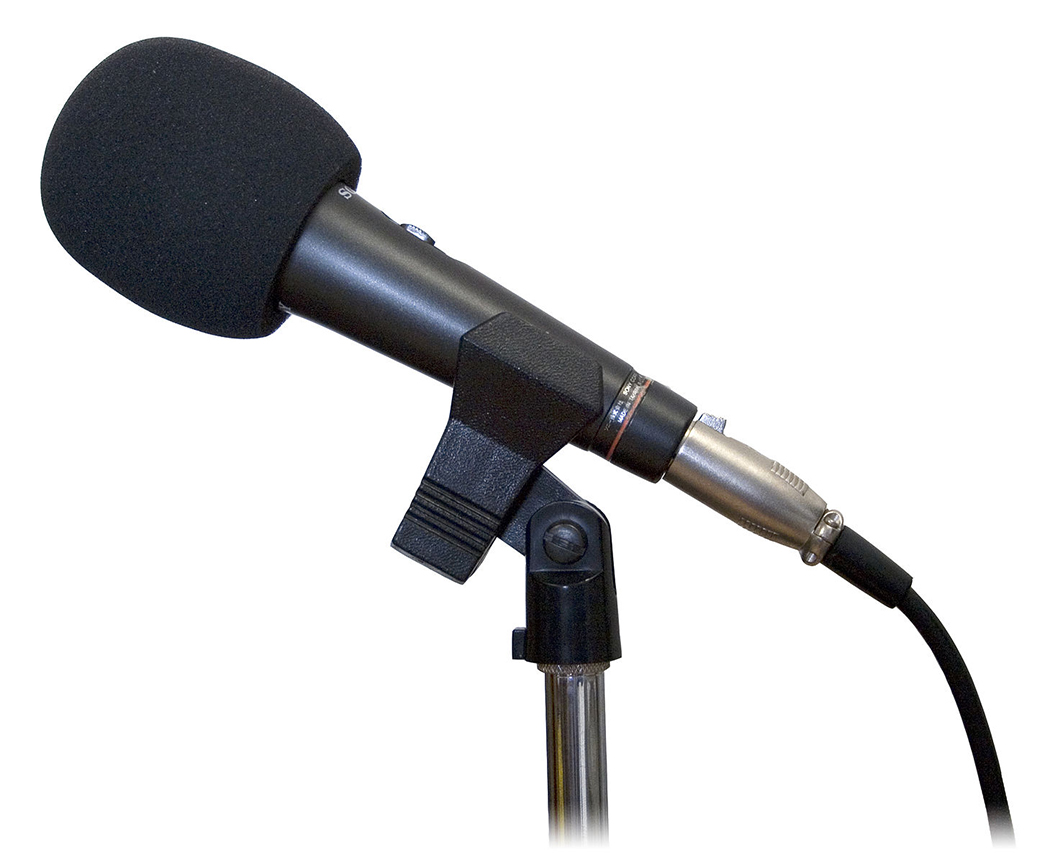 First, radio is broadcasting over the air (and also increasingly, also over the Internet, where it is called streaming or webcasting), while podcasts are recorded files distributed over the Internet through RSS (Really Simple Syndication). Podcasts can be played at the listener’s convenience on any app or device that supports it, of which there are many, including the phones in nearly everyone’s pocket or purse. It is also important to note that podcasting can be done by anyone anywhere (even from one of those phones) and does not require a license or a station, so the number of producers is limitless.
First, radio is broadcasting over the air (and also increasingly, also over the Internet, where it is called streaming or webcasting), while podcasts are recorded files distributed over the Internet through RSS (Really Simple Syndication). Podcasts can be played at the listener’s convenience on any app or device that supports it, of which there are many, including the phones in nearly everyone’s pocket or purse. It is also important to note that podcasting can be done by anyone anywhere (even from one of those phones) and does not require a license or a station, so the number of producers is limitless.
Second, since podcasters from the start have not enjoyed any kind of broad music licensing agreement with producers of recordings, podcasting has been almost all talk. (See, a podcaster needs to “clear rights” for every piece of music played. Live streamers such as Spotify, Apple and Amazon already have their rights cleared broadly through licensing systems.)
This is why podcasting and streaming are body-snatching radio from two sides: podcasting is becoming talk radio, while streaming is becoming music radio.
At the end of this trend, most radio listening will not be on radios, but on phones and other computing devices connected to the Internet. If the trend goes all the way, over-the-air radio will cease. This is already happening to AM radio (called MW outside North America), and may eventually happen to FM as well. Meanwhile, expect talk and music listening on the Internet to continue growing, through streaming and podcasting.
Tags: Industry · Media · Radio
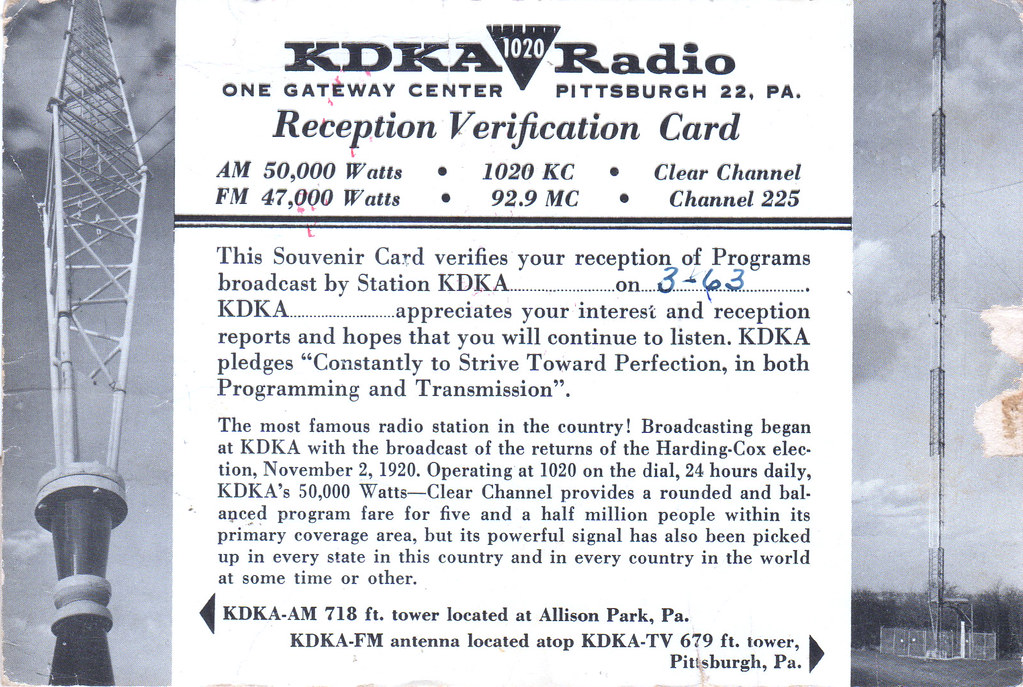
On the I Love AM Radio Facebook group, somebody asked if the branding of legacy AM stations, including giants WFAN/660 in New York and KDKA/1020 in Pittsburgh, would move entirely their FM side (101.9 and 100.1 respectively). I replied,
Eventually, the branding drops for both FM and AM. There will just be legacy callsigns, channels or nicknames, attached to streams on the Net.
As a native New York area sports fan, I enjoy listening to WFAN on 660 AM in the daytime from Cape Cod to Cape May and at night from Maine to the Carolinas—and in Indiana, where I’m living right now. The FM on 101.9 is good for the metro, but gone halfway across New Jersey or out Long Island.
While that may argue for keeping the AM signal alive and branded, another fact is that I can also get the station on my phone, and also in the dashboard of my car. Coverage may only be where there is cellular data; but that’s across most of the developed world. It also sounds better in streamed digital form.
Not that “tuning” into a stream is easy. WFAN has no app of its own. Nor does KDKA, which I’m listening to right now on the live stream on its website, which is a subdomain of the Audacy site. WFAN is similarly subordinated to the same corporate parent.
Both avoid mentioning their AM and FM channels. In the last fifteen minutes, its channels have not been mentioned by KDKA. On WFAN you hear the channels more (or at least 101.9, because they are still somewhat new to that channel and want to promote it).
KDKA’s traffic reporter just said, “on 100.1 FM and AM 1020, KDKA.” I thought that might be the official top-of-the-hour ID, but then the real thing came: a rapidly-spoken recording that said “KDKA AM and HD FM HD2 Pittsburgh. An Audacy station.” Let me unpack that:
• KDKA-AM still exists and may have HD. (Does it?)
• The same stream on FM is itself HD on W261AX/100.1, a 99-watt translator of KDKA-AM, which is also on the HD2 of KDKA-FM on 93.7.
All the big owners—Audacy (Formerly Radio.com, Entercom and CBS Radio), iHeart Radio (formerly Clear Channel), and Cumulus—know that radios have been replaced by phones in pockets and entertainment systems in dashboards and homes. The wireless that matters is digital and cellular, in the sense that home and car wi-fi are now effectively cellular as well. What will survive are branded forms of “content.” Some will be live shows, some will be podcasts, some will be streams of what were once stations and are now apps or streams within apps. AM and FM will eventually be gone. Until then they will survive as legacy expenses, necessary only as long as the FCC continues to require them.
Much as I love AM radio (or I wouldn’t be here), it is a dead band walking. Even for giants like WFAN and KDKA.
Tags: Industry · Media · Radio

To answer the question Where are SiriusXM radio stations broadcasted from?, I replied,
If you’re wondering where they transmit from, it’s a mix.
SiriusXM transmits primarily from a number of satellites placed in geostationary orbit, 35,786 kilometres or 22,236 miles above the equator. From Earth they appear to be stationary. Two of the XM satellites, for example, are at 82° and 115° West. That’s roughly aligned with Cincinnati and Las Vegas, though the satellites are actually directly above points along the equator in the Pacific Ocean. To appear stationary in the sky, they must travel in orbit around the Earth at speeds that look like this:
- 3.07 kilometres or 1.91 miles per second
- 110,52 kilometres or 6,876 miles per hour
- 265,248 kilometres or 165,025 miles per day
Earlier Sirius satellites flew long elliptical geosynchronous orbits on the “tundra“ model, taking turns diving low across North America and out into space again.
Satellites are also supplemented by ground repeaters. If you are in or near a site with repeaters, your Sirius or XM radio may be tuned to either or both a transmitter in space or one on the ground nearby. See DogstarRadio.com’s Satellite and Repeater Map to see if there is one near you.
In addition, SiriusXM also streams over the Internet. You can subscribe to radio, streaming or both.
As for studios, those are in central corporate locations; but these days, thanks to COVID-19, many shows are produced at hosts’ homes. Such is the case, for example, with SiriusXM’s popular Howard Stern show.
So, to sum up, you might say SiriusXM’s channels and shows are broadcast from everywhere.
I should add that I’ve been a SiriusXM subscriber almost from the start (with Sirius), and have owned two Sirius radios. The last one I used only once, in August of 2017, when my son and I drove a rental minivan from Santa Barbara to Love Ranch in central Wyoming to watch the solar eclipse. After that it went into a box. I still listen a lot to SiriusXM, almost entirely on the phone app. The rest of my listening is over the Web, logged in through a browser.
Item: a few days ago I discovered that a large bill from SiriusXM was due to a subscription for both the radio and the Internet stream. So I called in and canceled the radio. The subscription got a lot cheaper.
I bring this up because I think SiriusXM is an interesting one-company example of a transition going on within the infrastructure of what we used to call radio and would instead call streaming if we started from scratch today.
In The Intention Economy (Harvard Business Review Press, 2012), I saw this future for what we wouldn’t call television if we were starting from scratch today (or even when this was published, eight years ago):
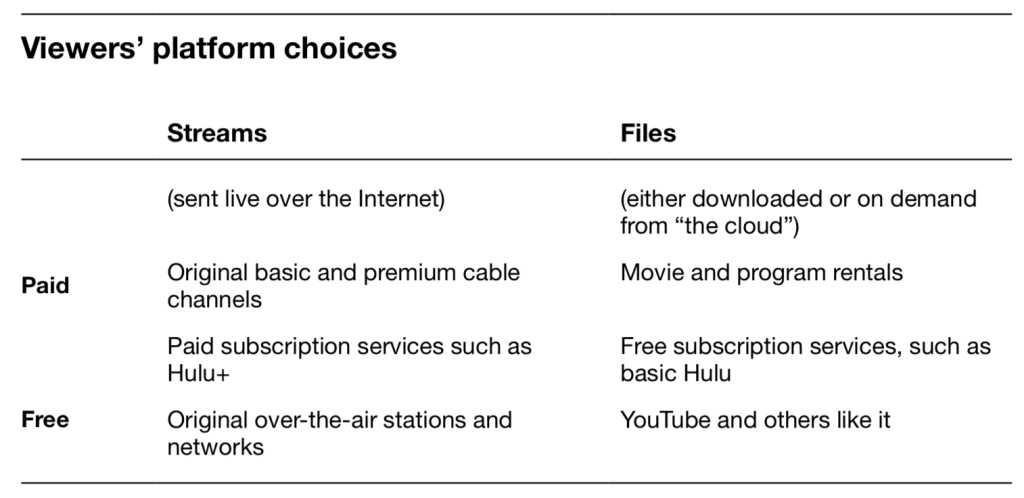
Today we’d put Netflix, Amazon Prime, YouTube TV and Apple TV in the upper left (along with legacy premium cable staples, such as HBO and Showtime). We’d put PBS stations there too, since those became subscription services after the digital transition in 2008 and subsequent spectrum sales, which reduced over-the-air TV to a way for stations to maintain their must-carry status on cable systems. (Multiple “repacks” of TV stations on new non-auctioned spectra have required frequent “re-scans” of signals on TVs of people who have antennas and still want to watch TV the old-fashioned way.)
Over-the-air radio is slower to die, but the sad fact is that it has been terminal for years. Here’s the diagnosis I published in 2016. I’ve also been keeping a photographic chronicle of radio in hospice, over on my Flickr account for Infrastructure. A touching example of one station’s demise is Abandoned America’s post on the forgotten but (then) still extant studios of WFBR (1924-1990) in Baltimore.
Like so much else, over-the-air radio is being subsumed into Internet streams and podcasts (in the two Free quadrants above).
Want to have some fun? Go to RadioGarden and look around the globe at streams from everywhere. My own current fave is little CJUC in Whitehorse, Yukon. (I list many others from earlier explorations here.) All of those are what we call “on” the Internet. But where is that?
We can pinpoint sources, as RadioGarden does, on a globe, but the Internet defies prepositions, because there is no “there” there. There is only here, where we are now, in this non-place, a functionally vast but geographically absent non-place: a giant zero with no distance and no gravity because its nature is to defy both. I’m in Santa Barbara right now, but could be anywhere. So could you.
On the Internet, over-the-air TV and radio are anachronisms, though charming ones. Like right now, as I’m listening to Capricorn FM from Polokwane, South Africa. (“Crazy up-tempo hip-hop” is the fare.) But I’m not listening on a radio, which would need to tune in 89.9fm, within range of the transmitter there. I’m here, on (or in, or through, or pick-your-preposition) the Internet.
Or consider the case of KSKO/89.5 in McGrath, Alaska, population 319. Here’s how it looks on Radio.Garden:
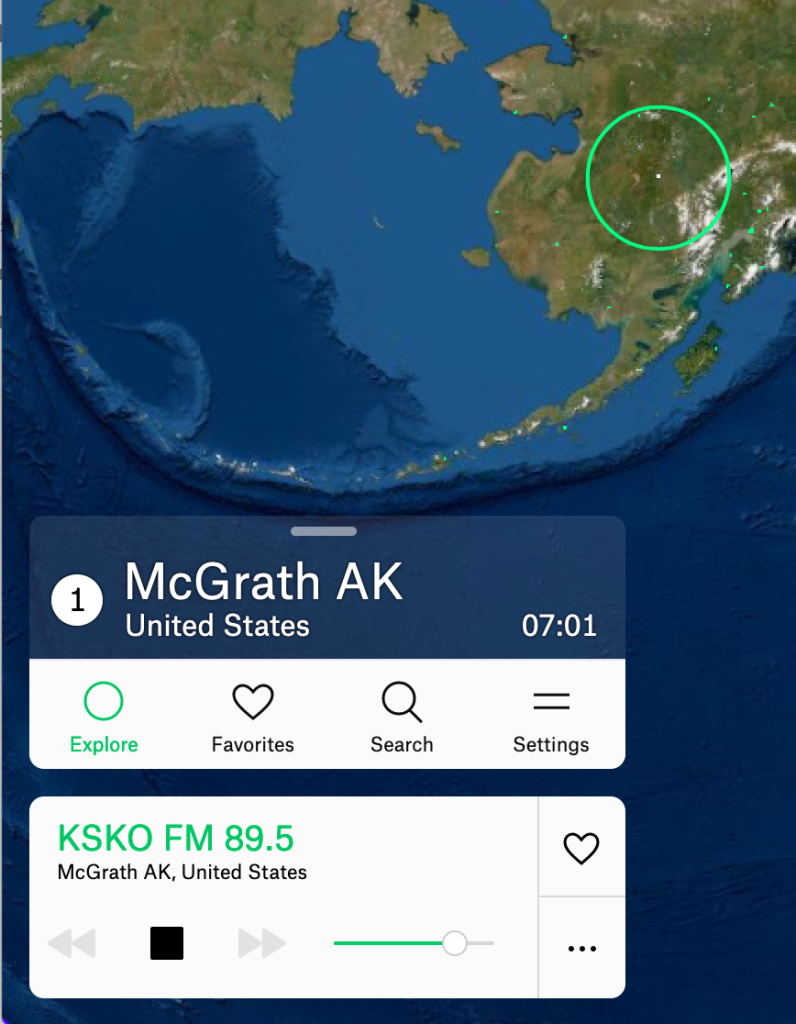
Geographically, McGrath elongates the meaning of “isolated.” No roads lead there from elsewhere. Visitors come and go to other parts of the world by plane, dogsled, or boat during months when the Kuskokwim River isn’t frozen. (The name is derived from the Yup’ik words for “big slow moving thing.”) In Coming Into the Country, the best book ever written about Alaska, John McPhee says “If anyone could figure out how to steal Italy, Alaska would be the place to hid it.” Power-wise, KSKO is just 90 watts, with an antenna on a pole beside the station. Since the population of McGrath is just 319, and nearly all are within shouting distance of each other, it doesn’t need to be bigger.
What matters, however, is that I’m listening to KSKO right now in Santa Barbara. (Before that I was digging the equally community-involved KIYU in Galena, 130 miles away, where the station a few minutes ago reported a temperature of -30°f. With “freezing icy fog” coming, a high of -15°f and a low tonight of -40°f. Fun.)
A few years ago my teenage son asked me what the point of “range” and “coverage” was for radio stations. Why, he wondered, was it a feature rather than a bug that radio stations’ signals faded away as you drove out of town? His frame of reference, of course, was the Internet. Not the terrestrial world where distance and the inverse square law apply.
Of course, we’ll always live in the terrestrial world. The Internet may go away, or get fractured into regions so telecom companies can bill for crossing borders and not just for use, or so governments can limit what can happen in their regions (as we already have in some countries, most notably China). But the Internet is also an infrastructural genie that is not going back in the bottle. And it is granting many wishes, all in a new here.
Tags: Geography · History · Media · Radio · Television
 If Hurricane Sandy lives up to expectations, it will be the biggest storm to hit the Northeast in recent history, if not in all of it. With attention to infrastructure, I’m listing infrastructure-grade information sources here, and following the stories over at Riding out the storm, on my personal blog.
If Hurricane Sandy lives up to expectations, it will be the biggest storm to hit the Northeast in recent history, if not in all of it. With attention to infrastructure, I’m listing infrastructure-grade information sources here, and following the stories over at Riding out the storm, on my personal blog.
Web links:
TV and Radio (going southwest to northeast):
Newspapers:
Tags: Emergency · Media · Radio · Roads/Bridges · Weather






 First, radio is broadcasting over the air (and also increasingly, also over the Internet, where it is called streaming or webcasting), while podcasts are recorded files distributed over the Internet through
First, radio is broadcasting over the air (and also increasingly, also over the Internet, where it is called streaming or webcasting), while podcasts are recorded files distributed over the Internet through 



